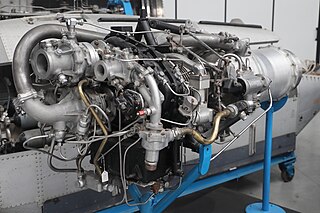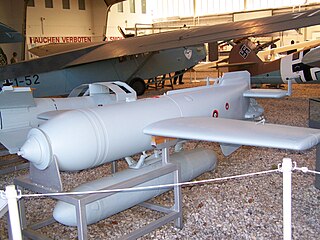
The Messerschmitt Me 163 Komet is a rocket-powered interceptor aircraft primarily designed and produced by the German aircraft manufacturer Messerschmitt. It is the only operational rocket-powered fighter aircraft in history as well as the first piloted aircraft of any type to exceed 1,000 kilometres per hour (620 mph) in level flight.

JATO is a type of assisted take-off for helping overloaded aircraft into the air by providing additional thrust in the form of small rockets. The term JATO is used interchangeably with the term RATO, for rocket-assisted take-off.

A hypergolic propellant is a rocket propellant combination used in a rocket engine, whose components spontaneously ignite when they come into contact with each other.
T-Stoff ([teː ʃtɔf]; 'substance T') was a stabilised high test peroxide used in Germany during World War II. T-Stoff was specified to contain 80% (occasionally 85%) hydrogen peroxide (H2O2), remainder water, with traces (<0.1%) of stabilisers. Stabilisers used included 0.0025% phosphoric acid, a mixture of phosphoric acid, sodium phosphate and 8-oxyquinoline, and sodium stannate.
C-Stoff was a reductant used in bipropellant rocket fuels developed by Hellmuth Walter Kommanditgesellschaft in Germany during World War II. It was developed for use with T-Stoff as an oxidizer, which together with C-Stoff as the fuel, forms a hypergolic mixture.

Hellmuth Walter was a German engineer who pioneered research into rocket engines and gas turbines. His most noteworthy contributions were rocket motors for the Messerschmitt Me 163 and Bachem Ba 349 interceptor aircraft, so-called Starthilfe jettisonable rocket propulsion units used for a variety of Luftwaffe aircraft during World War II, and a revolutionary new propulsion system for submarines known as air-independent propulsion (AIP).

The Junkers Jumo 004 was the world's first production turbojet engine in operational use, and the first successful axial compressor turbojet engine. Some 8,000 units were manufactured by Junkers in Germany late in World War II, powering the Messerschmitt Me 262 fighter and the Arado Ar 234 reconnaissance/bomber, along with prototypes, including the Horten Ho 229. Variants and copies of the engine were produced in Eastern Europe and the USSR for several years following the end of WWII.

The Messerschmitt Me 263 Scholle (plaice) was a rocket-powered fighter aircraft developed from the Me 163 Komet towards the end of World War II. Three prototypes were built but never flown under their own power as the rapidly deteriorating military situation in Germany prevented the completion of the test program.

The Mitsubishi J8M Shūsui is a Japanese World War II rocket-powered interceptor aircraft closely based on the German Messerschmitt Me 163 Komet. Built as a joint project for both the Navy and the Army Air Services, it was designated J8M (Navy) and Ki-200 (Army).

The DFS 346 was a German rocket-powered swept-wing aircraft which began development during World War II in Germany. It was designed by Felix Kracht at the Deutsche Forschungsanstalt für Segelflug (DFS), the "German Institute for Sailplane Flight". A prototype was constructed but did not reach completion before the end of the war. It was taken to the Soviet Union where it was completed, tested and flown.

A liquid-propellant rocket or liquid rocket utilizes a rocket engine that uses liquid propellants. Gaseous propellants may also be used but are not common because of their low density and difficulty with common pumping methods. Liquids are desirable because they have a reasonably high density and high specific impulse (Isp). This allows the volume of the propellant tanks to be relatively low. The rocket propellants are usually pumped into the combustion chamber with a lightweight centrifugal turbopump, although some aerospace companies have found ways to use electric pumps with batteries, allowing the propellants to be kept under low pressure. This permits the use of low-mass propellant tanks that do not need to resist the high pressures needed to store significant amounts of gasses, resulting in a low mass ratio for the rocket.
The XLR11, company designation RMI 6000C4, was the first liquid-propellant rocket engine developed in the United States for use in aircraft. It was designed and built by Reaction Motors Inc., and used ethyl alcohol and liquid oxygen as propellants to generate a maximum thrust of 6,000 lbf (27 kN). Each of the four combustion chambers produced 1,500 lbf (6.7 kN) of thrust. The engine was not throttleable but each chamber could be turned on and off individually.

The Reaction Motors LR99 engine was the first large, throttleable, restartable liquid-propellant rocket engine. Development began in the 1950s by the Reaction Motors Division of Thiokol Chemical Company to power the North American X-15 hypersonic research aircraft. It could deliver up to 57,000 lbf (250 kN) of thrust with a specific impulse of 279 s (2.74 km/s) or 239 s (2.34 km/s) at sea level. Thrust was variable from 50 to 100 percent, and the restart capability allowed it to be shut down and restarted during flight when necessary.
Z-Stoff was a name for calcium permanganate or sodium permanganate mixed in water. It was normally used as a catalyst for T-Stoff in military rocket programs by Nazi Germany during World War II.

The de Havilland Spectre is a rocket engine that was built by the de Havilland Engine Company in the 1950s. It was one element of the intended mixed power-plant for combination rocket-jet interceptor aircraft of the Royal Air Force, such as the Saunders-Roe SR.177.
Hellmuth Walter Kommanditgesellschaft (HWK), Helmuth Walter Werke (HWM), or commonly known as the Walter-Werke, was a German company founded by Professor Hellmuth Walter to pursue his interest in engines using hydrogen peroxide as a propellant.
The BMW 109-718 was a liquid-fuelled rocket engine developed by BMW at their Bruckmühl facility, in Germany during the Second World War.

The Walter HWK 109-500 was a liquid-fuelled rocket engine developed by Walter in Germany during the Second World War.
The BMW 109-558 is a liquid fuelled sustainer rocket motor developed by BMW at their Bruckmühl facility, in Germany during the Second World War.

The HWK 109-507 was a liquid-propellant rocket engine developed by Germany during World War II. It was used to propel the Hs 293 anti-ship guided missile.
















